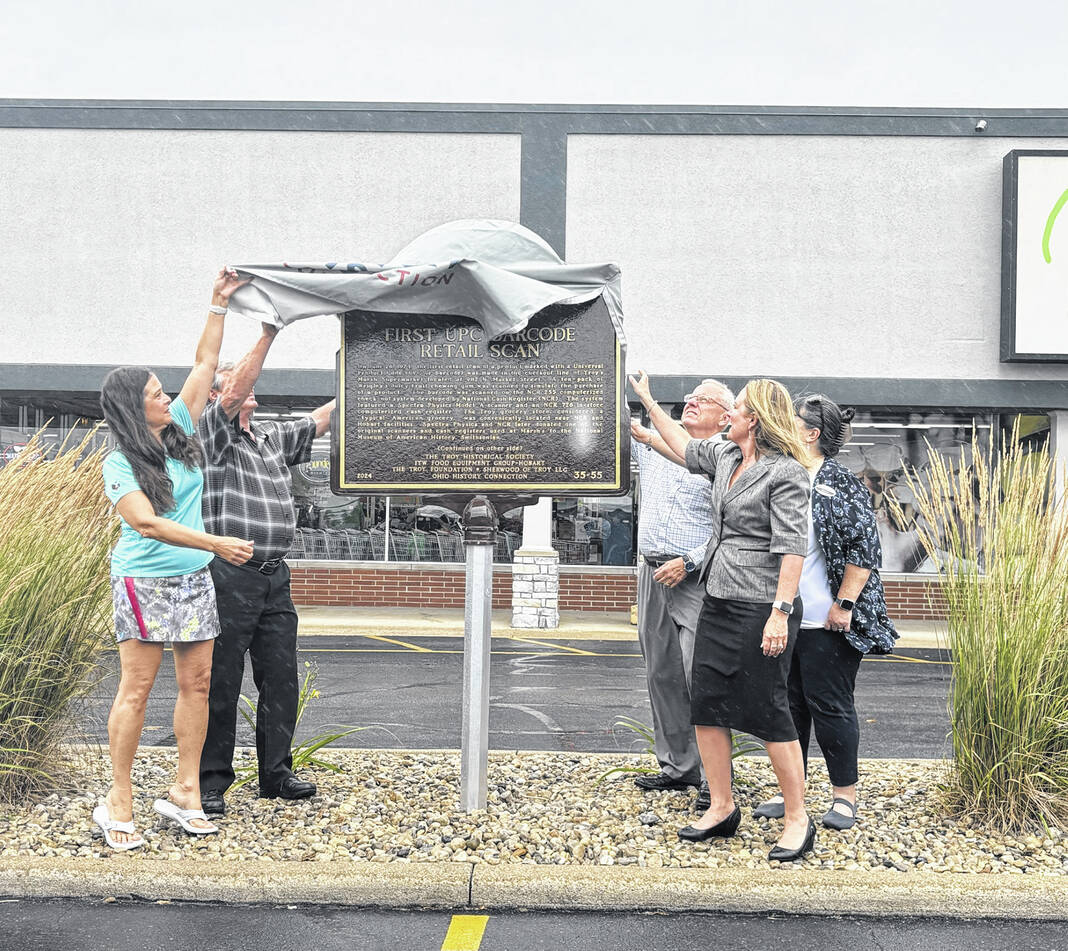
Beth Hunter, daughter of Sharon Buchanan, the Marsh supermarket cashier in 1974; left to right, and Claude Fenstermaker, 1974 Marsh co-manager; Steve Overmyer, manager in 1974 of Hobart data center; Jennifer Monnin, of Hobart; and Gwen Haney, of Dayton History, unveils the Ohio History Connection historical marker of the first UPC barcode retail scan celebrating the 50th anniversary of the first barcode scan. The event took place on a rainy Wednesday afternoon, on June 26, in front of the former Marsh supermarket, now known as Needlers on North Market Street in Troy.
Carly Rose | Miami Valley Today
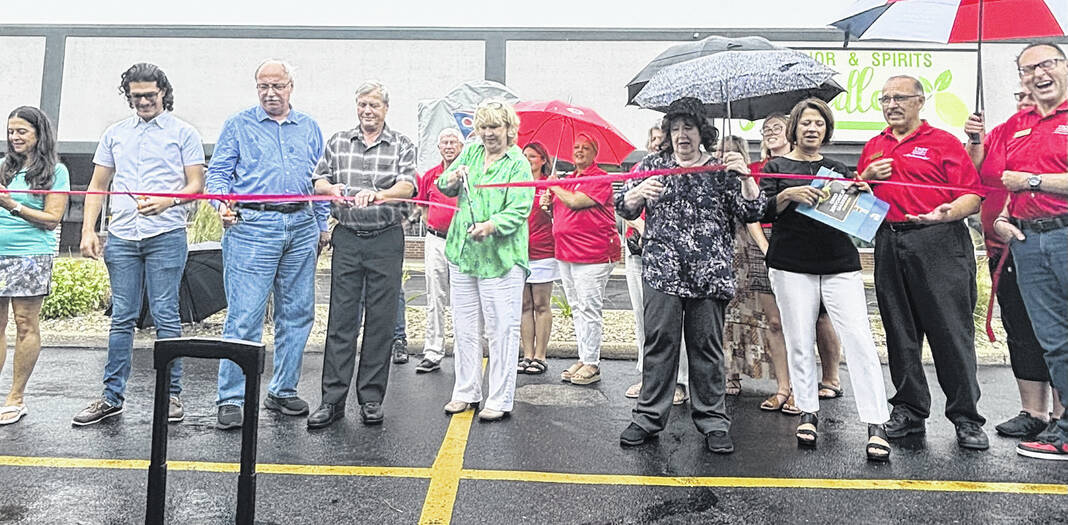
Troy Mayor Robin Oda cuts the ribbon, surrounded by several members of the Troy community, to celebrate the 50th anniversary of the first barcode scan which occurred on June 26, 1974. After the ribbon cutting was the unveiling of the Ohio History Connection historical marker of the first UPC barcode retail scan Wednesday afternoon, on June 26, in front of the former Marsh supermarket, now known as Needlers on North Market Street in Troy.
Carly Rose | Miami Valley Today
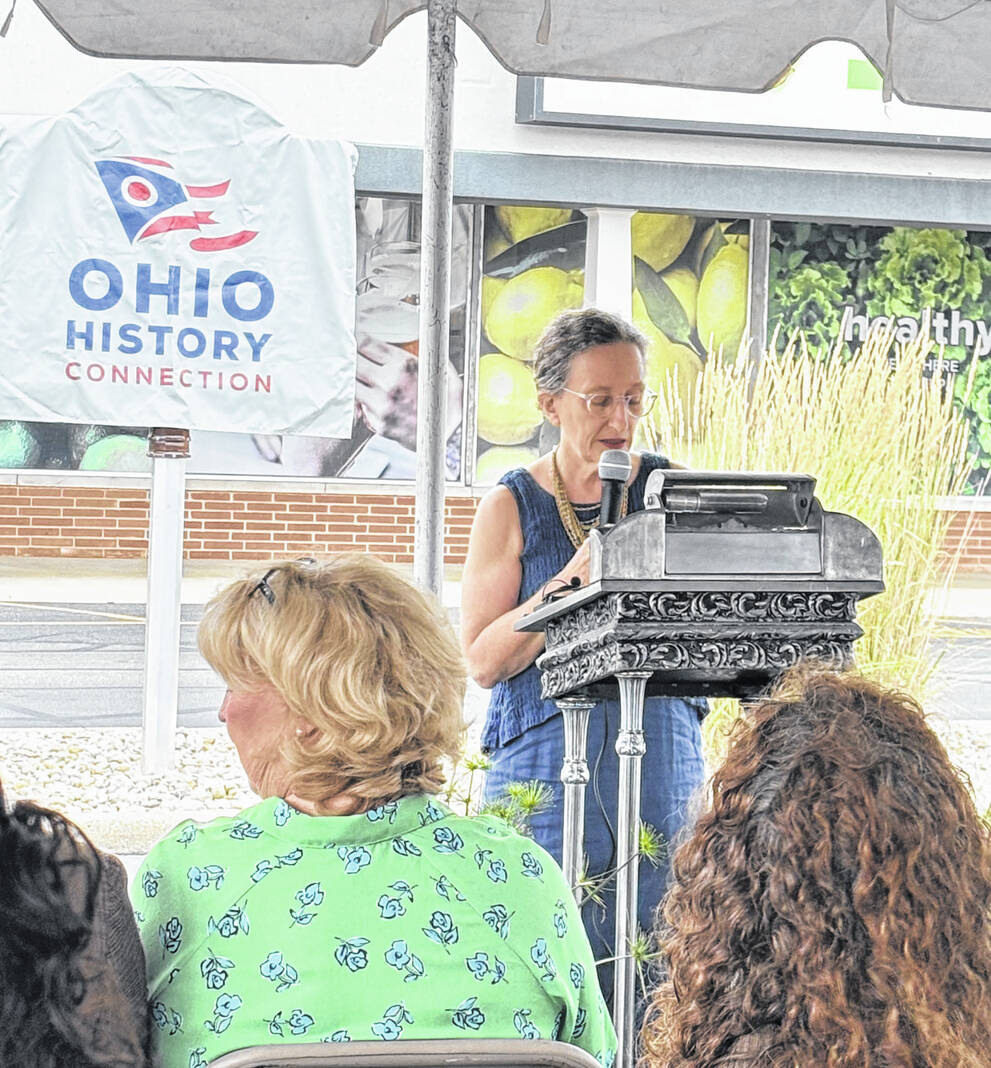
Susan Woodland, daughter of Norman Joseph “Joe” Woodland who designed the UPC barcode, spoke about her late father’s process of solving of supermarkets’ checkout and cashier error problems Wednesday afternoon, on June 26, in front of the former Marsh supermarket, now known as Needlers on North Market Street in Troy.
Carly Rose | Miami Valley Today
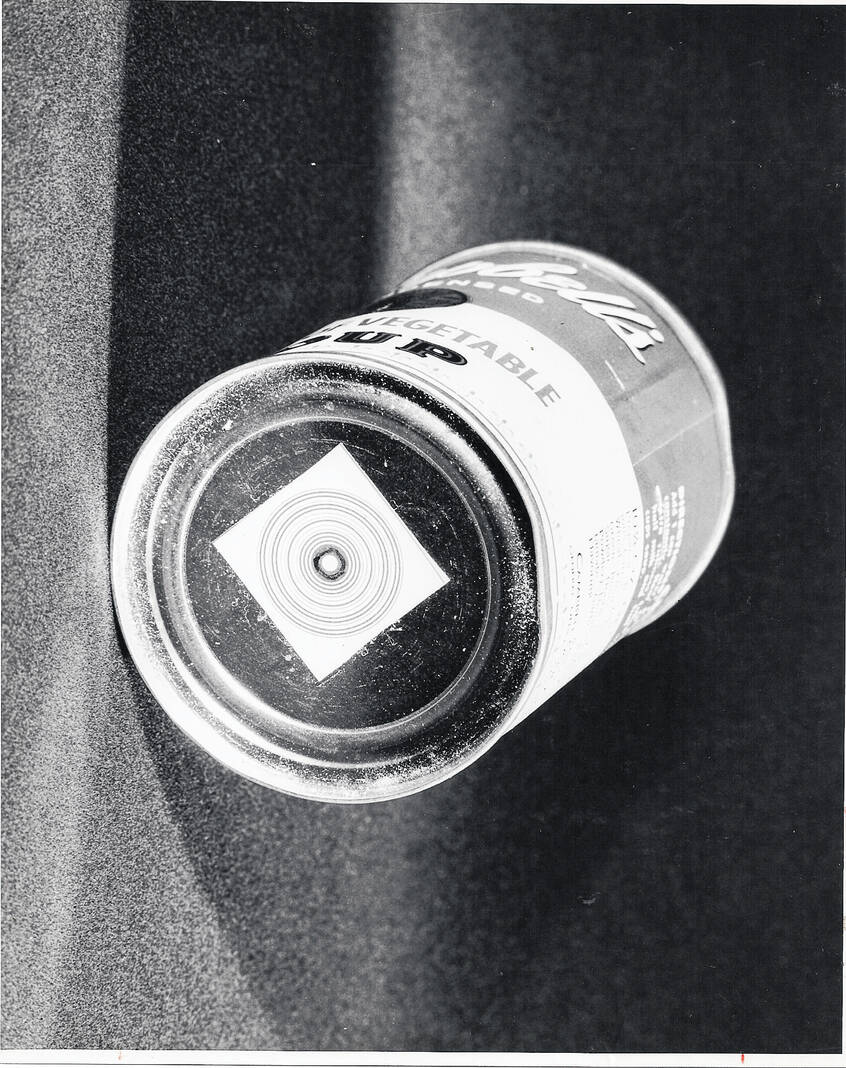
An early model for the UPC barcode utilized a bulls-eye design, which was made by an IBM testing group in the early 1970s.
Courtesy photos | Susan Woodland
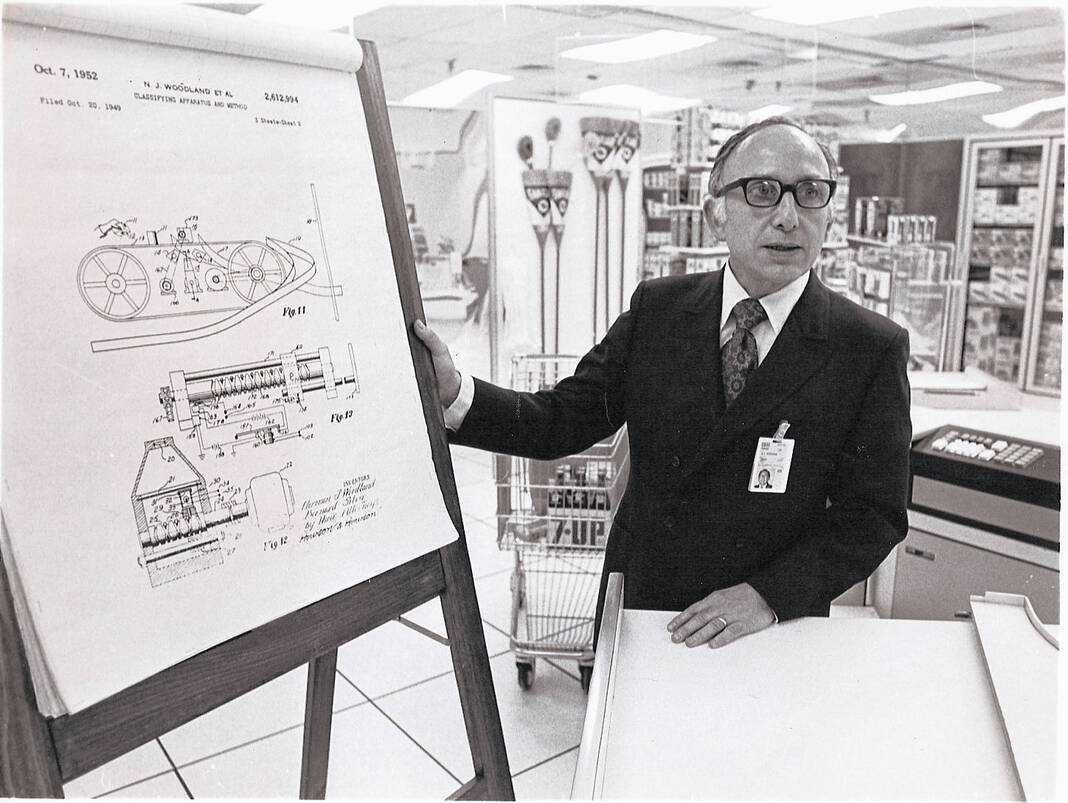
Norman Joseph “Joe” Woodland, gives a presentation to IBM circa 1974 with an early patent for the UPC barcode.
Courtesy photos | Susan Woodland
By Eamon Baird
TROY — The city of Troy commemorated the 50th anniversary of the first scanned Universal Product Code (UPC) on Wednesday, June 26.
On June 26, 1974, Clyde Dawson purchased a 10-pack of Wrigley’s Juicy Fruit gum for 67 cents at the Marsh Supermarket in Troy. The gum was scanned using an NCR 255.
The successful scan constituted over 25 years of work to solve a problem.
The problem
While working on his electrical engineering Master of Business Administration (MBA) at Drexel University in the late 1940s Norman Joseph “Joe” Woodland was approached by friend Bernard Silver with a unique problem.
Susan Woodland spoke about her father working through the problem.
“Silver walked by the dean’s office and heard a president of the supermarket chain FoodShare and he was asking the dean, he said, ‘I have a problem that I’d like to pose to your students, and maybe it’s a project you’d like them to work on,’” she said.
The problem was for grocery stores to figure out a way to speed checkout and prevent cashier keying errors.
“So, Bernard went over to my dad and said, ‘Joe, I think you’d be interested in this; that’s kind of up your alley,’ and my dad immediately was interested in that whole project,’” Susan said.
Woodland, who served in World War II, moved to Miami in 1948. It was there where he had a flash of inspiration that he remembered from his days in the boy scouts.
“The way he described it was, one day, he takes his chair down to the beach and he’s thinking about this problem. He knew it needed some kind of a code, that could be captured and check out, and the only code he knew at the time was Morse code,” she said.
To read the codes, Woodland came up with a way of shining lines to a light sensitive tube on the other side that converted the varying brightness of the light coming through the paper into electric waves that could process and deliver information.
The updated design changed from the Morse code dots and dashes to a bullseye design, because they thought this would be easier scanned from all angles. The first real-life test of the bullseye design was at a Kroger in Cincinnati, on July 3, 1972. However, during the scanning process the bullseye design tended to smear, making the scanned product unreadable.
By the early 1970s, there were multiple companies submitting designs for the UPC barcode including RCA and IBM.
Woodland, whose bullseye patent was sold to RCA, eventually realized his design was outdated and vouched for a competitor in IBM.
“My dad told RCA it was a really good symbol 25 years ago when I designed it,” she said.“Because my dad understood technically how these symbols worked. So, he was able to be part of the persuasion machine team at IBM.”
George Laurer, worked with Woodland and mathematician David Savir at IBM. It was Laurer’s design that eventually became the standard for UPC barcodes.
Connections to Troy
In 1974, the Uniform Code Council (UCC) was founded as a means to administer standards for the UPC barcode. UCC eventually changed its name to GS1.
Judy Deeter, director for the Troy Historical Society, talked about why GS1 chose Troy for the first UPC scan.
“They didn’t want a big place or super-sized grocery store. They wanted something smaller; the average American grocery store, and there used to be a lot of independent grocers in 1974. And I think NCR actually picked Marsh,” Deeter said.
The National Cash Register Company (NCR) began in Dayton in 1884 in Dayton.
Another company crucial in the development and implementation of the barcode was the Hobart Electrical manufacturing company, founded in Troy in 1897.
The Hobart 3000 was used in wrapping and labeling meat and to scan random weight items such as meats, fruits and vegetables.
“Because a barcode could not be placed on those items, Hobart Corporation developed a way to weigh and wrap variable weight items so that a UPC barcode could be placed on such items with the use of a label,” Deeter said.
When Dawson made the first purchase using the barcode, he was head of research and development for Marsh Supermarket. He later explained he chose the product because nobody was sure that a barcode could be printed on something as small as a piece of chewing gum.
Deeter said the Wrigley’s company worked to implement a barcode to fit on their product.
“Onlookers thought he just randomly pulled it out of his cart, but he said he really wanted to see if that would work and he had an appreciation for what they had done,” she said speaking about Dawson’s relationship with Wrigley’s.
Mass appeal
While Dawson’s scan of Wrigley’s gum was successful, it took years to implement the UPC barcode throughout the United States.
Some shoppers felt they were being overcharged, while others were worried about lasers scanning their products.
However, in the early 1980s the sentiment shifted, as retail corporations Kmart and Walmart implemented UPC barcodes into their stores.
In addition to faster checkout and less cashier errors, the UPC codes could be tracked by computers, making inventory more expedient. Barcodes are now used in countless industries to assist in supply chain management
In 1992, Woodland received the National Medal of Technology from President George H.W. Bush in recognition for his contributions to the UPC barcode.
In 2011, Woodland and Silver, who died in in 1963, were jointly inducted into the National Inventors Hall of Fame.
Woodland passed away in on Dec. 9, 2012, at the age of 91.
According to GS1, UPC barcode is scanned more than 5 billion times every day.


